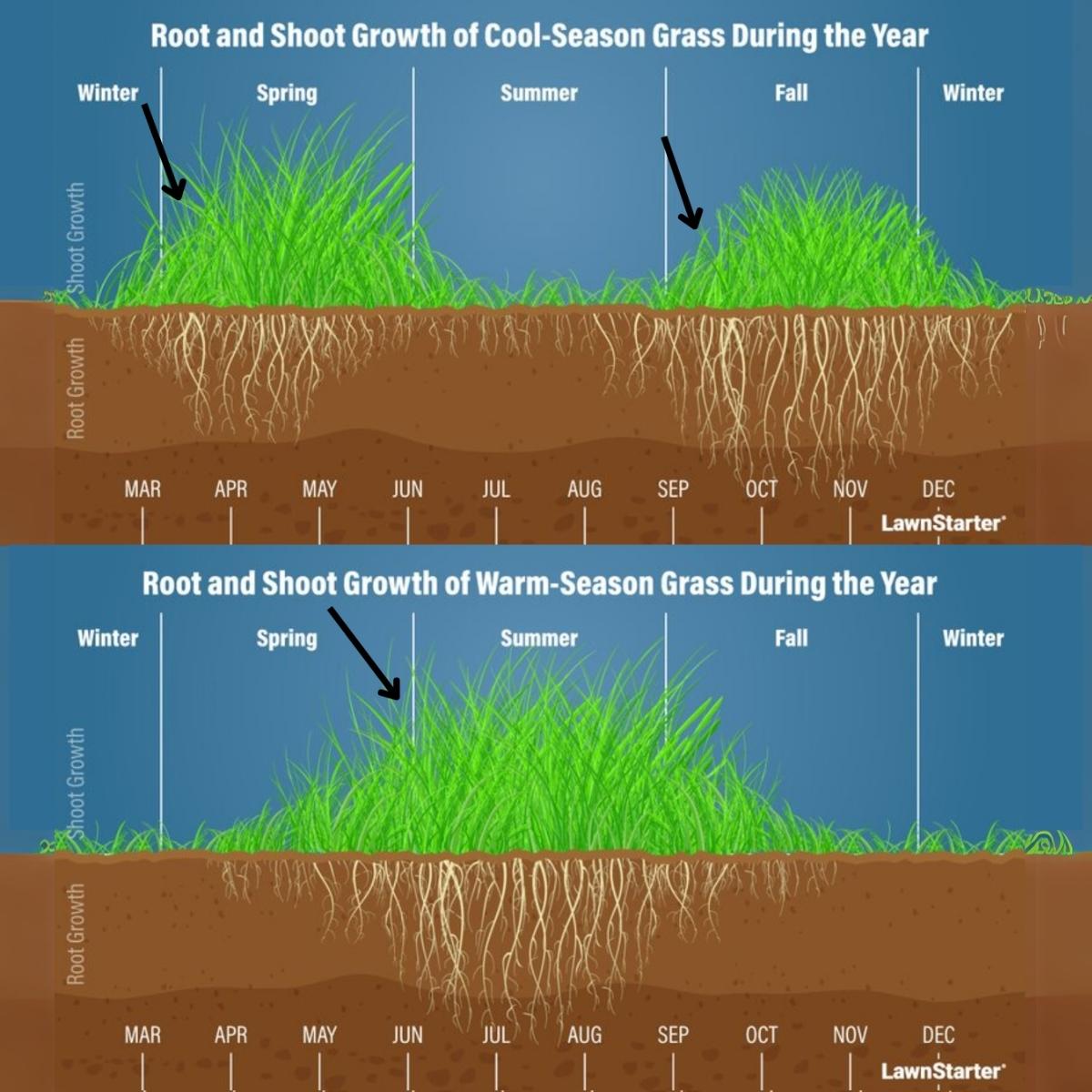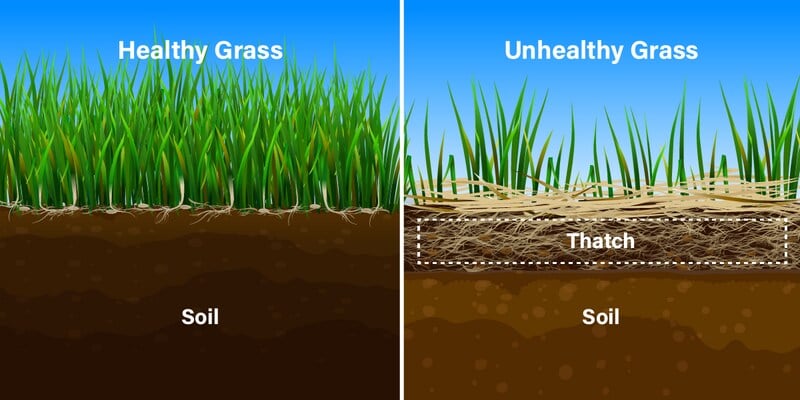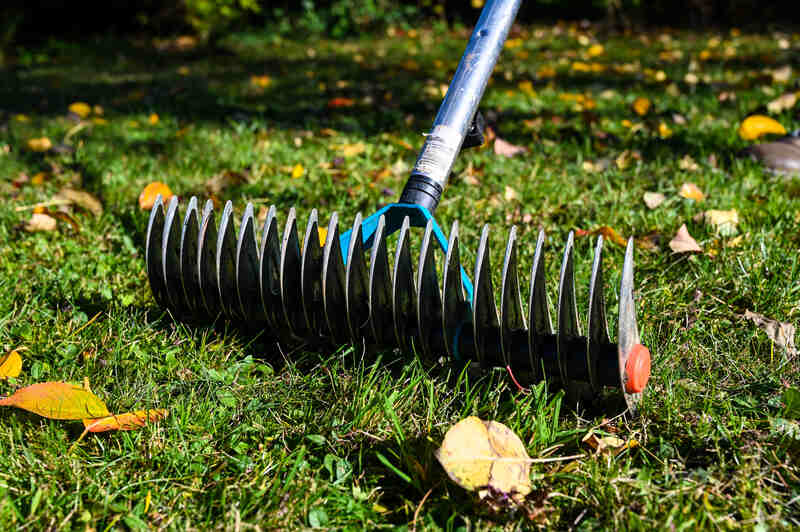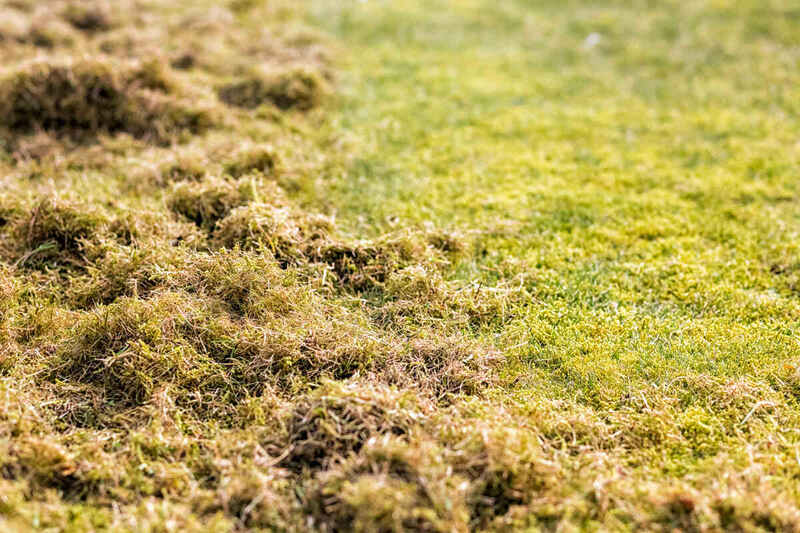
Dethatch the lawn at the start of your grass’s optimal growth period. The rule of thumb is to dethatch southern grasses in late spring to early summer and northern grasses in early spring or early fall.
I’ll also explain how air temperature and weather factor in, and we’ll hear from Dr. Wendell Joseph Hutchens, Assistant Professor of Turfgrass Science at the University of Arkansas, to learn how to maintain your lawn so excess thatch doesn’t develop in the first place.
Why Timing Matters

Thatch is a dense layer of dead and living roots, stems, and blades that may prevent your grass from properly accessing nutrients, water, air, and sunlight. When properly timed, dethatching boosts grass health and leads to strong, dense turfgrass, but at the wrong time, it can do more harm than good.
See Related: What is Thatch in Your Lawn?
Grass Recovery Depends on the Season
Dethatching is an intensive lawn care treatment that can pierce blades, cut stems, and nick roots. It should only be applied during the grass’s optimal growth period when the turf is able to repair itself.
Weather Can Help or Harm
The ideal time to dethatch your lawn is a day with mild weather that protects the grass from heat stress. If it rained recently, wait a few days so the soil can dry out a bit. Moist soil (neither wet nor dry) is ideal.
It’s even better if you can allow for three to four weeks between dethatching and stressful weather (high heat, first frost) for lawn recovery. That is usually how long the grass needs to completely bounce back from the mechanical stress.
Pro Tip: Dethatch early in the morning after the dew dries out. The cool morning temperatures make the work more comfortable, especially if you’re removing the thatch layer with a manual rake.
Pairs Well With Other Lawn Treatments
Choosing the best time to dethatch your grass also involves coordinating with other treatments in your lawn care calendar. Dethatching frees the soil surface of debris and enhances aeration, overseeding, fertilization, and topdressing. It’s worthwhile to schedule them together to save time and maximize your lawn’s health.
Pro Tip: Dethatch and/or aerate first. Dethatching and aeration give grass seed, fertilizer, and topdressing better access to the soil layer.
See Related:
- Can You Dethatch and Aerate at the Same Time?
- How to Aerate and Overseed Your Lawn
- When and How Often Should You Fertilize Your Lawn?
You Need Time to Prepare
Preparing your lawn for dethatching reduces damage to the grass and makes it easier for the dethatcher to reach the thatch layer. Here’s how to prepare:
- Clean debris.
- Mow the grass shorter (about 1 1/2 inches for cool-season grasses and 3/4 inch for warm-season grasses).
- Irrigate if the soil is too dry.
Depending on the condition and size of the lawn, this can take a few hours or a few days. For example, if you keep the lawn tall, you might need several mowing sessions to trim it to the desired height.
See Related: How to Mow Tall Grass In Your Lawn
Best Time to Dethatch Warm-Season Grasses
The best time of year to dethatch a warm-season lawn is late spring to early summer when the grass is actively growing and exposed to less heat and drought stress.
Southern grasses like Bermudagrass, Zoysia, and St. Augustine thrive between 80 to 95 degrees Fahrenheit. They go dormant when the weather cools in the fall and start growing again the next spring. This gives you a perfect window for dethatching and setting up the turf early in the year for a nice, carpet-like look during the warm season.
How early can you dethatch your lawn? Wait a couple of weeks after the lawn greens up in spring, or, if it’s easier to remember, consider the second mow of the year as the earliest time to dethatch.
Avoid dethatching too close to hot, dry spells over 95 degrees Fahrenheit that can stress even warmth-loving summer grasses.
See Related: Guide to Growing Warm-Season Grasses
Best Time to Dethatch Cool-Season Grasses
Northern grasses have two growing seasons during which you can dethatch: spring and fall. However, the best time to dethatch a cool-season lawn is late summer to early fall, starting in August. Though not ideal, you can dethatch as late as October or three to four weeks before the first frost. In the fall, weeds are not so virulent, and it’s also an ideal time to aerate and overseed.
When you dethatch the lawn in the spring (February to March), that beautiful, clean soil might invite stubborn weeds to pop up all around the lawn. If spring dethatching is the only option, apply a pre-emergent herbicide afterward.
Use these tips to ensure you choose a good time to dethatch your northern lawn:
- Spring: Dethatch after the second mow of the year, but at least a couple of weeks before air temperatures rise over 75 degrees Fahrenheit.
- Fall: Wait until the heat subsides and your cool-season lawn starts to grow vigorously again. Dethatch no later than three to four weeks before the first frost.
See Related: Guide to Growing Cool-Season Grasses
Best Time to Dethatch Mixed Lawns

Bermuda lawns in the southern and western United States are often overseeded with ryegrass for winter cover while Bermuda is dormant. Bermuda is a heavy thatch producer that requires yearly dethatching, and knowing when to dethatch is essential to transition correctly between the two species.
The best time to dethatch a mixed lawn with Bermuda and rye is late spring to early summer when Bermuda is actively growing, and ryegrass starts to die back because of the heat.
A thorough dethatching at this time helps remove the dead ryegrass and prepares the lawn for fall overseeding.
See Related: How to Overseed a Lawn in 8 Simple Steps
How Often to Dethatch
The rule of thumb is to dethatch yearly, but some experts say it’s better to dethatch when needed rather than on a routine basis. Take the best of both sides: Check for thatch yearly and decide based on what you find.
The frequency of dethatching depends on how easily thatch accumulates. Some types of grass, soils, and lawn care practices support thatch buildup and can lead to more frequent dethatching.
Type of Grass
Perennial ryegrass and tall fescue produce thatch slowly, if at all, so you’ll only need to dethatch such a lawn once every few years, if ever. Even so, it’s wise to always keep an eye on signs that indicate a thatch problem.
Bermudagrass, Zoysia, St. Augustine, and Kentucky bluegrass produce many rhizomes and/or stolons (stems) that decay slowly and quickly add up to an overgrown thatch layer. Lawns with these grass species usually need to be dethatched yearly.
Lawns installed with sod are also more prone to thatch than seeded ones. Sod is often heavily fertilized in sod farms and will produce lots of organic matter. It also has a thick layer of roots that often have a hard time burying deep into a lawn’s dirt. Many roots remain shallow, dry out, and add to the thatch.
Note: It’s rare for a lawn to require dethatching two times a year, even with fast-growing hybrid Bermuda.
Lawn Maintenance
Too much TLC can boost the thatch layer and add dethatching to your yearly lawn care calendar.
Dr. Hutchens says that “excessive applications of fertilizer and water will lead to thatch buildup and actually reduce plant health. Too much of a good thing can be a bad thing, and this is the case with fertilizer and irrigation on turfgrasses,” says Dr. Hutchens.
See Related: How to Prevent Thatch in Your Lawn
Soil Quality
Expect to dethatch more often if your lawn grows on heavy clay soil that is prone to compaction, sandy soil low in organic matter, or soil with unbalanced pH.
According to Dr. Hutchens, “Soil pH can play a significant role in thatch buildup or decomposition. When soil pH levels are too acidic (~below 5.5), then microbial activity is hindered, and thatch is allowed to build up more rapidly because there are fewer microbes to break down the thatch. The same problem can occur if soil pH is too high.”
Such soils don’t support earthworms and soil microbes that decompose the thatch and are among the common causes of thatch buildup.
See related: Reasons Why Soil Testing Is Important for the Lawn
Thatch Thickness
Thatch that is more than 1-inch thick is often a sign of a long-term problem. If you find this in your lawn, turfgrass specialists at the University of Missouri explain that mechanically dethatching overly thick thatch in a single session damages the living plants, and it’s better if done gradually.
“In such cases, moderate maintenance over two to three years may be more desirable than attempting complete removal in a single operation,” say the experts.
See Related: How to Dethatch Your Lawn
How Do You Know Your Lawn Needs Dethatching?

Suspect you might have a thatch problem when you feel the lawn spongy and bouncy under your feet? Maybe, but you’ll need to check because some root-eating lawn pests, like grubs, also give this carpet-like feeling.
To check the thatch layer, dig out a few plugs of grass about 3 inches deep from several spots around the lawn. Then, measure the thatch layer — the brown, fibrous, felt-like layer between the soil and green grass.
If it’s over 1/2-inch thick, you need to manage it: dethatch (with a rake, power rake, or a verticutter) and adjust lawn care practices to prevent further build-up.
Other signs that indicate a thatch problem on your lawn include:
- Thin, diseased turf.
- Uneven surfaces that are hard to mow.
- A lower resilience to heat, especially in cool-season grasses.
- Footprints that are still visible after an hour.
FAQ
Don’t dethatch the lawn during hot summer days or in winter. Also, avoid dethatching during a drought or on wet soil and when the turfgrass is already stressed by other factors.
Wait one year, a full growing season after the installation, before dethatching a new lawn to ensure the turfgrass is properly established, with strong, healthy roots in the soil.
Yes, you can aerate and dethatch at the same time. Plan the dethatching first since it helps the aerator better penetrate the soil.
The Best Timing is Professional Timing
Lawn care pros know exactly when and how to remove the thatch from your lawn. Find a trusted lawn care company with LawnStarter and give your grass the best chance for healthy and lush growth this season.
LawnStarter pros can also help prevent thatch buildup with top-notch lawn maintenance, including lawn mowing, leaf removal, aeration, and fertilization.
Sources:
- Fresenburg, B.S. (2015). Managing Thatch in Home Lawns. https://extension.missouri.edu/publications/g6708
- Munshaw, G. (2014).Aerifying and Dethatching Lawns. https://publications.ca.uky.edu/files/agr54.pdf
- Watson, F.M. (2015). Thatch is the enemy of home lawns. College of Agricultural and Environmental Sciences, University of Georgia. https://newswire.caes.uga.edu/story/5453/lawn-thatch.html
- University of Massachusets Amherst (2012, June). What is Thatch? https://ag.umass.edu/turf/fact-sheets/what-is-thatch
- University of Florida (n.d). Overseeding Florida Lawns for Winter Color. https://sfyl.ifas.ufl.edu/archive/hot_topics/lawn_and_garden/overseeding_winter_lawns.shtml
Main Image Credit: Infographic by Juan Rodriguez